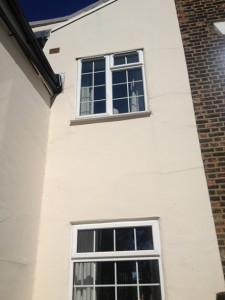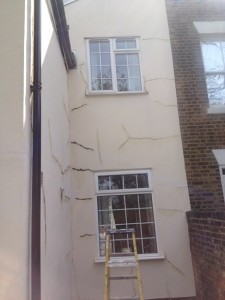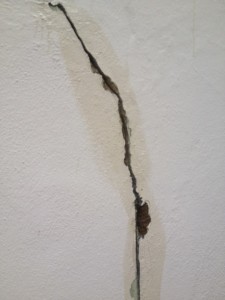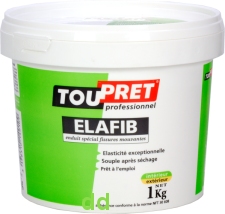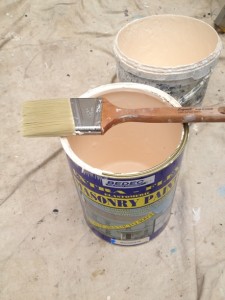We were recently asked how to deal with cracks in masonry, not just a cosmetic fix but something that would prevent the cracks from coming back a few months down the line. The property in question is a brick built, end of terrace Victorian. At some point a previous owner had decided to render all the external elevations which restricted the building’s ability to ‘breathe’ and caused some damp problems internally, this is turn caused recurring cracks in the render which can be seen below.
Our customer had previously been paying for the property to be painted every couple of years by other decorators, only for the cracks to reappear in a relatively short space of time. Granted, the masonry is always going to be problematic as somebody has interfered with the design of the building but we were sure we could come up with a specification that would not only stop these cracks from reopening but also stop any new cracks from forming. We started by raking out all of the failed filler and caulk that previous painters had used, also removing any loose material in and around the cracks. We really opened them up!
We then flooded stabilising solution into the cracks; this was used to ‘bind down’ all the friable and porous material inside the crack. By stabilising the crack it ensures adhesion for the next stage of the repair, paint or filler applied to a powdery surface is likely to fail pretty quickly.
We then used Toupret Murex filler to level up the cracks flush with the surface. Murex is cement based, all-purpose powder filler that has no thickness limitation and is highly impact resistant with exceptional adhesion to most substrates. It is ideal as a long term solution for filling deep holes like we had here.
We then spread Toupret Elafib across the pre-filled cracks. Elafib is a synthetic, highly flexible, ready mixed filler that is used for preventing problem cracks. Elafib should not be used for filling deep holes due to its 3mm thickness limitation. Because the masonry at this property had a fairly coarse texture it was also important to spread it thin in order for the repair to be invisible on completion. It is important not to leave Elafib ‘proud’ when applying as it cannot be rubbed down.
While the Elafib was still wet be bedded in Toupret Bridging Scrim to reinforce the repair. Toupret’s range of knitted polyamide scrim tapes are designed for use in the treatment and reinforcement of moving cracks and joints which can be used internally or externally. They have a long life expectancy and have excellent resistance to the spread of cracks.
This was left overnight to dry, imperfections around the repair were resolved by using HallsBeeline Red Devil One Time filler. Red Devil is a lightweight, ready mixed filler. It’s uses are fairly limited but in this instance we found it to be more than adequate for hiding irregularities around the crack repairs.
With the cracks now taken care of it was time to get the paint out! With flexibility in mind we specified three coats of Bedec Extra Flex elastomeric masonry paint as the protective coating. Extra Flex is a modified acrylic blend that is flexible and breathable. It will flex with the substrate where movement causes cracking in conventional masonry paint. It also has a very smooth satin finish.
With the extra steps taken in reinforcing the cracks with appropriate materials we can guarantee that this exterior painting job will last far longer than previously, our client thought we did a cracking job… if you’ll excuse the pun!
If you found this article interesting then you can subscribe to our blog here.
